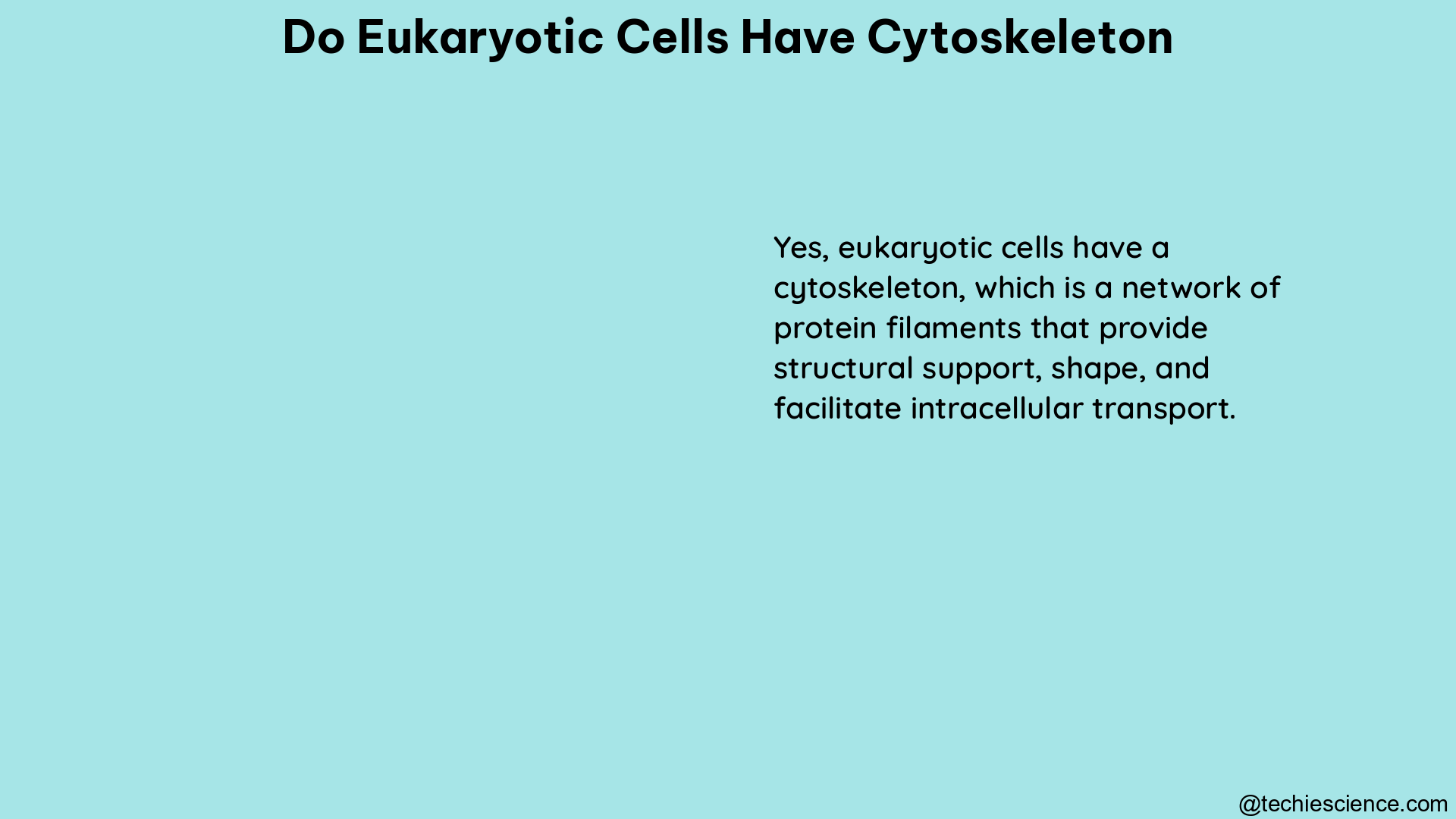Eukaryotic cells possess a dynamic, three-dimensional, and interconnected network of filamentous proteins embedded within the cytoplasm, known as the cytoskeleton. This remarkable structure plays a pivotal role in maintaining the shape, mechanical resistance, and various cellular processes of eukaryotic cells, making it a fundamental aspect of their biology.
The Cytoskeletal Filaments: Microfilaments, Microtubules, and Intermediate Filaments
The cytoskeleton is composed of three major types of filaments, each with its unique structure and function:
- Microfilaments (Actin Filaments):
- Diameter: ~6 nm
- Composition: Actin proteins
-
Functions:
- Maintaining cell shape
- Facilitating intracellular and intercellular transport
- Enabling cell motility
-
Microtubules:
- Diameter: ~23-25 nm
- Composition: Tubulin proteins
-
Functions:
- Intracellular transport
- Cell division (forming the spindle apparatus)
- Maintaining cell shape
-
Intermediate Filaments:
- Diameter: ~10 nm
- Composition: Diverse family of proteins (e.g., keratin, desmin, peripherin)
- Functions:
- Maintaining cell shape
- Organizing the internal structure of the cell
The Dynamic Nature of the Cytoskeleton

The cytoskeleton is a highly dynamic structure, constantly undergoing reorganization and remodeling in response to various intracellular and extracellular signals. This dynamic nature is crucial for the cell’s ability to adapt to changing environmental conditions and perform essential functions.
Regulation of Cytoskeletal Dynamics
The organization and dynamics of the cytoskeleton can be modulated by various mechanisms, including:
-
Polymerization and Depolymerization: The assembly and disassembly of cytoskeletal filaments are tightly regulated, allowing the cell to rapidly reorganize its internal structure.
-
Posttranslational Modifications: Cytoskeletal proteins can undergo various posttranslational modifications, such as phosphorylation, acetylation, and glycosylation, which can alter their stability, interactions, and functions.
-
Accessory Proteins: A wide range of accessory proteins, such as motor proteins, cross-linking proteins, and severing proteins, interact with the cytoskeletal filaments to control their dynamics and organization.
-
Signaling Pathways: Intracellular signaling cascades, triggered by extracellular stimuli, can modulate the activity and organization of the cytoskeleton, enabling the cell to respond to changes in its environment.
The Cytoskeleton and Cellular Nanoarchitecture
Emerging techniques, such as partial wave spectroscopic (PWS) microscopy, have revealed the importance of the cytoskeleton in maintaining the nanoscale organization of the cell. PWS microscopy can measure the statistical properties of cell nanoarchitecture, known as the disorder strength, which has been found to be an early indicator of carcinogenesis.
Cytoskeleton and Cellular Disorder Strength
Studies have shown that selective drug treatments targeting specific cytoskeletal components in human colon cancer cell lines can lead to the attenuation of disorder strength differences, indicating that the cytoskeleton plays a crucial role in controlling the nanoscale organization of the cell.
This relationship between the cytoskeleton and cellular nanoarchitecture highlights the importance of the cytoskeleton in maintaining the delicate balance of the cell’s internal structure, which is essential for proper cellular function and behavior.
The Cytoskeleton and Cellular Processes
The cytoskeleton is a fundamental component of eukaryotic cells, playing a crucial role in various cellular processes:
- Cell Shape and Mechanical Support:
-
The cytoskeletal filaments provide the cell with its characteristic shape and mechanical resistance to deformation, allowing it to withstand external forces.
-
Intracellular Transport:
-
Cytoskeletal filaments, in conjunction with motor proteins, facilitate the movement of organelles, vesicles, and other cellular components within the cell.
-
Cell Division:
-
During cell division, the microtubules form the spindle apparatus, which is responsible for separating the chromosomes and ensuring their equal distribution to the daughter cells.
-
Cell Motility:
-
The dynamic reorganization of the cytoskeletal filaments, particularly the actin microfilaments, enables various forms of cell movement, such as amoeboid movement, ciliary/flagellar movement, and muscle contraction.
-
Signal Transduction:
- The cytoskeleton can act as a scaffold for signaling molecules, facilitating the transmission of signals within the cell and between cells.
Conclusion
The cytoskeleton is a crucial component of eukaryotic cells, providing mechanical support, maintaining cell shape, and playing a pivotal role in various cellular processes. The dynamic nature of the cytoskeleton, regulated by a complex network of mechanisms, allows the cell to adapt to changing environmental conditions and perform its essential functions.
Moreover, the cytoskeleton’s involvement in the maintenance of cellular nanoarchitecture highlights its importance in the delicate balance of the cell’s internal structure, which is crucial for proper cellular function and behavior. Understanding the intricate workings of the cytoskeleton is, therefore, a fundamental aspect of eukaryotic cell biology and has far-reaching implications in fields such as cell biology, developmental biology, and cancer research.
References:
- Cytoskeleton – an overview | ScienceDirect Topics
- Why is the cytoskeleton important to eukaryotic cells? – Socratic
- Cell mechanics and the cytoskeleton – PMC – NCBI
- Microtubules, Filaments | Learn Science at Scitable – Nature
- Role of Cytoskeleton in Controlling the Disorder Strength of Cellular Nanoarchitecture
Hi..I am Moumita Nath, I have completed my Master’s in Biotechnology. I always like to explore new areas in the field of Biotechnology.
Apart from this, I like to read, travel and listen to Music.